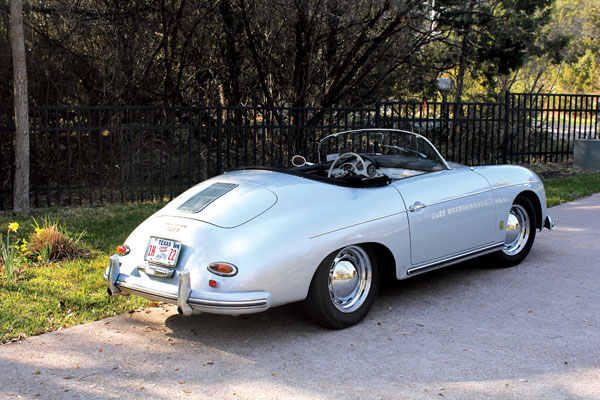No chassis number available
By 1956, the Porsche 356 had been continually developed into one of the world’s most respected sports cars. This feat was quite remarkable considering that Porsche as a company was only celebrating its eighth anniversary. The evolution of the Porsche 356 was swift and further impelled not only by Porsche’s drive for technical improvement but also by the realities of commercial success.
The Speedster’s origins are well-known—built at the insistence of the legendary Max Hoffman, Porsche’s U.S. importer.
Hoffman recognized the special needs of the U.S. market and encouraged—if not coerced—his European partners into building specific models to meet them. The Speedster was one of the most famous and successful fruits of Hoffman’s effort.
It was a Spartan, purpose-built sporting machine with minimal equipment. Priced at $2,995 to East Coast ports of entry, the seats were skimpy, the mostly-useless top tiny, and the car dispensed with the luxury of roll-up windows.
As compared to the 356, the new Speedsters included a revised windshield that significantly lowered the look of the car. A chrome strip down the side of the car was also added, and gone were unnecessary items, such as an effective top. Instrumentation had been reworked to only three dials: speedometer, oil temperature and optional tachometer. Seating was also changed with the addition of bucket seats with little mobility. Nevertheless, these cars looked great and were even more exciting and fun to drive. With the reduced weight from eliminating many trim items, the experience of driving a Speedster was remarkably different from the standard Cabriolet.
According to the Kardex, this was in fact a true “Super Speedster.” The car offered here has been garaged and covered in a climate-controlled environment since a full and complete restoration in 2002.
The pan-up overhaul preceded a return to a concours-correct original exterior and interior color combination. With fewer than 2,000 careful break-in miles on the new, Shasta-built C engine since restoration, no mechanical aspect of the car was overlooked. In addition to being a Super, this Speedster featured quite a few unusual options, including comfortable leather coupe seats, tonneau cover and one outside mirror on the driver’s side.

